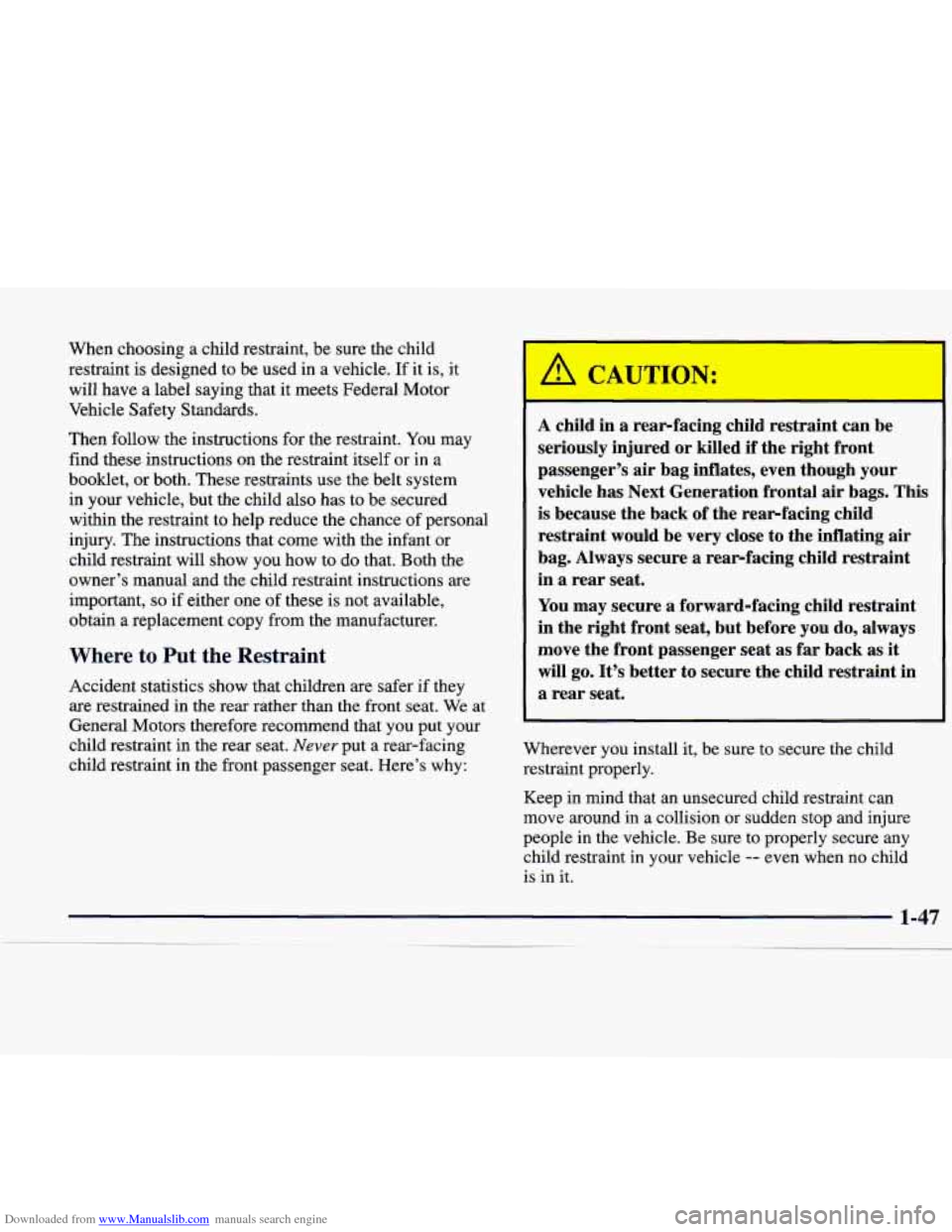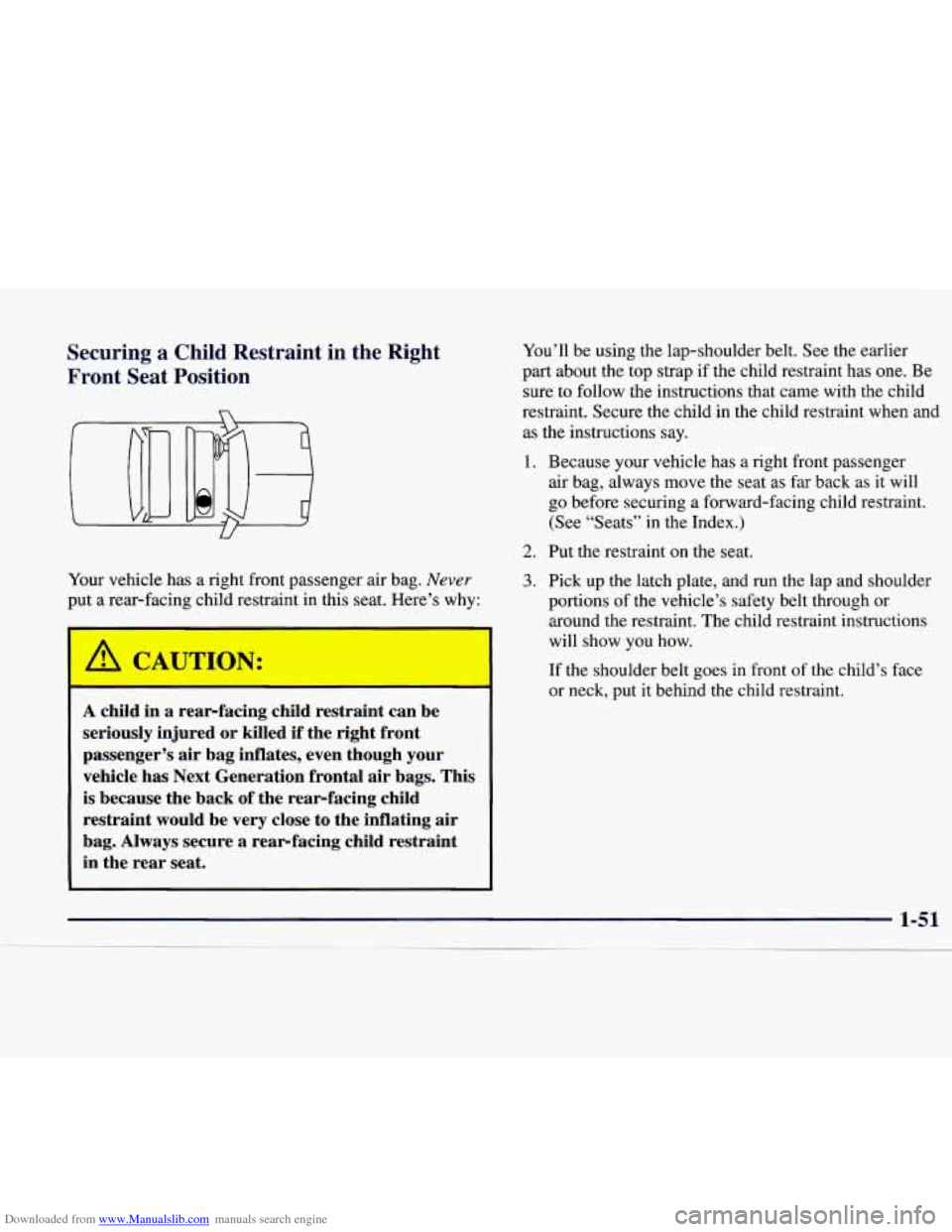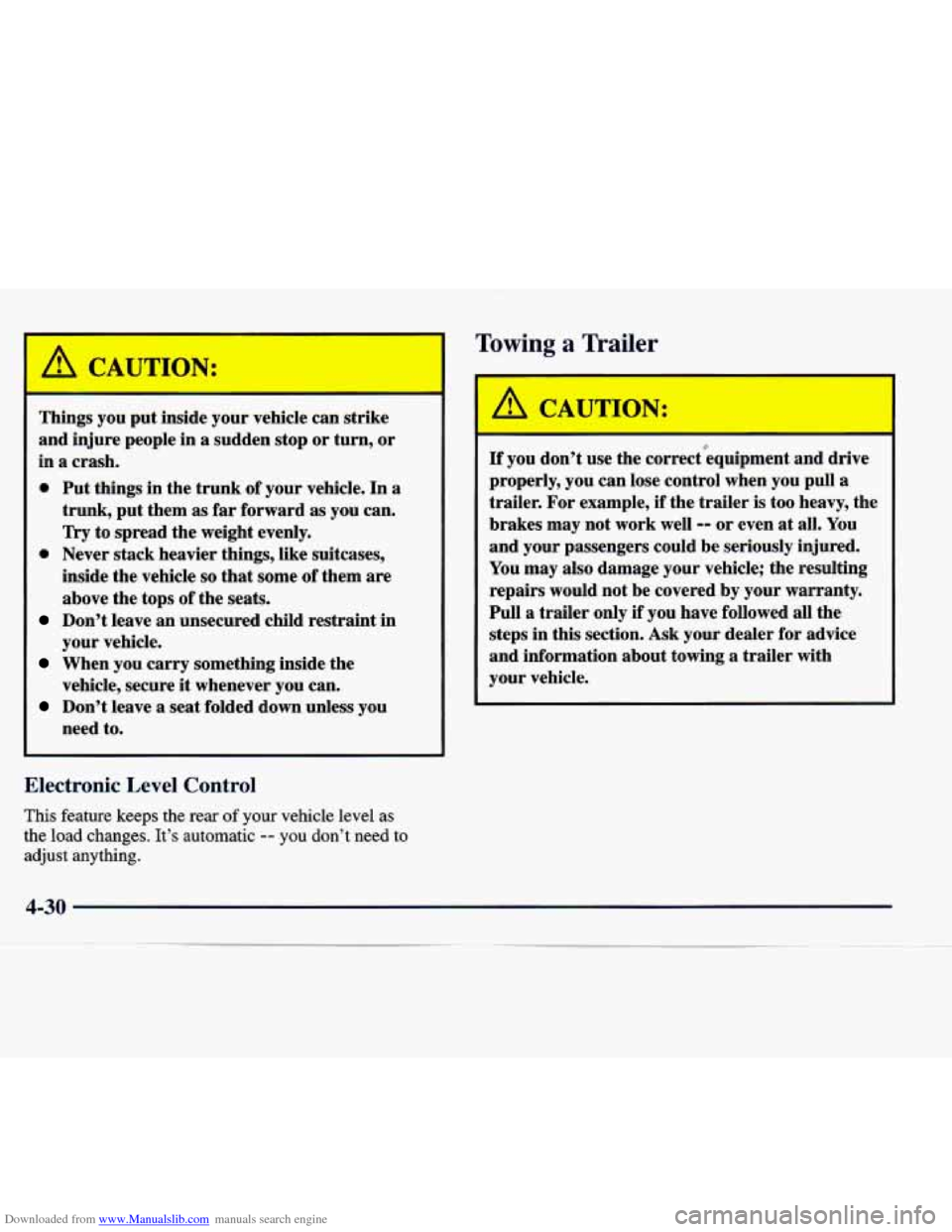Page 60 of 346

Downloaded from www.Manualslib.com manuals search engine When choosing a child restraint, be sure the child
restraint is designed to be used in a vehicle. If it
is, it
will have a label saying that it meets Federal Motor
Vehicle Safety Standards.
Then follow the instructions for the restraint. You may
find these instructions on the restraint itself or in
a
booklet, or both. These restraints use the belt system
in your vehicle, but the child also has to be secured
within the restraint to help reduce the chance
of personal
injury. The instructions that come with the infant or
child restraint will show
you how to do that. Both the
owner’s manual and the child restraint instructions are
important,
so if either one of these is not available,
obtain a replacement copy from the manufacturer.
Where to Put the Restraint
Accident statistics show that children are safer if they
are restrained in the rear rather than the front seat. We at
General Motors therefore recommend that you put your
child restraint in the rear seat.
Never put a rear-facing
child restraint in the front passenger seat. Here’s why:
I
A child in a rearfacing child restraint can be
seriously injured or killed if the right front
passenger’s air bag inflates, even though your
vehicle has Next Generation frontal air bags, This
is because the back of the rearfacing child
restraint would be very close
to the inflating air
bag. Always secure a rearfacing child restraint
in a rear seat,
You may secure a forward-facing child restraint
in the right front seat, but before you
do, always
move the front passenger seat
as far back as it
will
go. It’s better to secure the child restraint in
a rear seat.
Wherever you install it, be sure to secure the child
restraint properly.
Keep in mind that an unsecured child restraint can
move around in
a collision or sudden stop and injure
people in the vehicle.
Be sure to properly secure any
child restraint in your vehicle
-- even when no child
is in it.
Page 61 of 346
Downloaded from www.Manualslib.com manuals search engine If your child restraint has a top strap, it should be
anchored. If you need to have an anchor installed, you
can ask your Catera dealer to put it in for you. If you
want to install
an anchor yourself, your dealer can tell
you how to do it.
Canadian law requires that child restraints have
a top
strap, and that the strap be anchored.
Page 62 of 346
Downloaded from www.Manualslib.com manuals search engine You’ll be using the lap-shoulder belt. See the earlier part
about the top strap if the child restraint has one. Be sure
to follow the instructions that came with the child
restraint. Secure the child in the child restraint when and
as the instructions say.
1. Put the restraint on the seat.
2. Pick up the latch plate, and run the lap and shoulder
portions of the vehicle’s safety belt through or
around the restraint. The child restraint instructions
will show you how.
If the shoulder belt goes in front of the child’s face or
neck, put it behind the child restraint.
3. Buckle the belt. Make sure the release button is
positioned
so you would be able to unbuckle the
safety belt quickly
if you ever had to.
1-49
Page 63 of 346
Downloaded from www.Manualslib.com manuals search engine 4. Pull the rest of the shoulder belt all the way out of
the retractor to set the lock. 5. To tighten the belt, feed the shoulder belt back into the
retractor while you push down on the child restraint.
If
you’re using a forward-facing child restraint, you may
find it helpful to use your knee to push down
on the
child restraint as you tighten the belt.
directions to be sure it is secure.
6. Push and pull the child restraint in different
To remove the child restraint, just unbuckle the vehicle’s
safety belt and let it go back all the way. The safety belt
will move freely again and be ready to work for an adult
or larger child passenger.
I 1-50
Page 64 of 346

Downloaded from www.Manualslib.com manuals search engine Securing a Child Restraint in the Right
Front Seat Position You’ll be using the lap-shoulder belt. See the earlier
part about the top strap if the child restraint has one.
Be
sure to follow the instructions that came with the child
restraint. Secure the child in the child restraint when and
as the instructions say.
1.
Your vehicle has a right front passenger air bag. Never
put a rear-facing child restraint in this seat. Here’s why:
2.
3.
I
A child in a rear-facing child restraint can be
seriously injured or killed if the right front
passenger’s air bag inflates, even though your
vehicle has Next Generation frontal air bags. This
is because the back of the rear-facing child
restraint would be very close to the inflating air
bag. Always secure
a rear-facing child restraint
in the rear seat.
Because your vehicle has a right front passenger
air bag, always move the seat as far back as it will
go before securing a forward-facing child restraint.
(See “Seats” in the Index.)
Put the restraint on the seat.
Pick up the latch plate, and run the lap and shoulder
portions
of the vehicle’s safety belt through or
around the restraint. The child restraint instructions
will show you how.
If the shoulder belt goes in front of the child’s face
or neck, put it behind the child restraint.
Page 66 of 346
Downloaded from www.Manualslib.com manuals search engine 6. To tighten the belt, feed the shoulder belt back into the
retractor while you push down on the child restraint.
You may find it helpful to use your knee to push down
on the child restraint as you tighten the belt.
7. Push and pull the child restraint in different
directions to be sure it is secure.
Larger Children
Children who have outgrown child restraints should
wear the vehicle’s safety belts.
To remove the child restraint, just unbuckle the vehicle’s
safety belt and let it go back all the way. The safety belt
will move freely again and be ready to work for an adult
or larger child passenger.
1-53
Page 67 of 346

Downloaded from www.Manualslib.com manuals search engine Accident statistics show that children are safer if they
are restrained in the rear seat. But they need
to use the
safety belts properly.
Children who aren’t buckled up can be thrown out in
a crash.
Children who aren’t buckled up can strike other
people who
are.
4
Never do this.
Here two children are wearing the same belt. The
belt can’t properly spread the impact forces. In a
crash, the two children can be crushed together
and seriously injured.
A belt must be used by
only one person at a time.
&= What if a child is wearing a lap-shoulder belt,
but the child is
so small that the shoulder belt is
very close to the child’s face or neck?
A: If the child is sitting in a seat next to a window,
move the child toward the center of the vehicle.
If
the child is sitting in the center rear seat passenger
position, move the child toward the safety belt
buckle. In either case, be sure that the shoulder belt
still is on the child’s shoulder,
so that in a crash the
child’s upper body would have the restraint that
belts provide.
Page 209 of 346

Downloaded from www.Manualslib.com manuals search engine CAUTION:
Things you put inside your vehicle can strike
and injure people in
a sudden stop or turn, or
in
a crash.
0 Put things in the trunk of your vehicle. In a
trunk, put them as far forward as you can.
Try to spread the weight evenly.
0 Never stack heavier things, like suitcases,
inside the vehicle
so that some of them are
above the tops of the seats.
Don’t leave an unsecured child restraint in
your vehicle.
When you carry something inside the
vehicle, secure
it whenever you can.
Don’t leave a seat folded down unless you
need to.
Electronic Level Control
This feature keeps the sf your vehicle level as
the load changes. It’s automatic
-- you don’t need to
adjust anything.
Towing a Trailer
: CAUTION:
If you don’t use the correct”equipment and drive
properly, you can lose control when you pull a
trailer. For example, if the trailer is too heavy, the
brakes may not work well
-- or even at all. You
and your passengers could be seriously injured.
You may also damage your vehicle; the resulting
repairs would not be covered by your warranty.
Pull a trailer only if you have followed all the
steps in this section.
Ask your dealer for advice
and information about towing a trailer with
your vehicle.
4-30